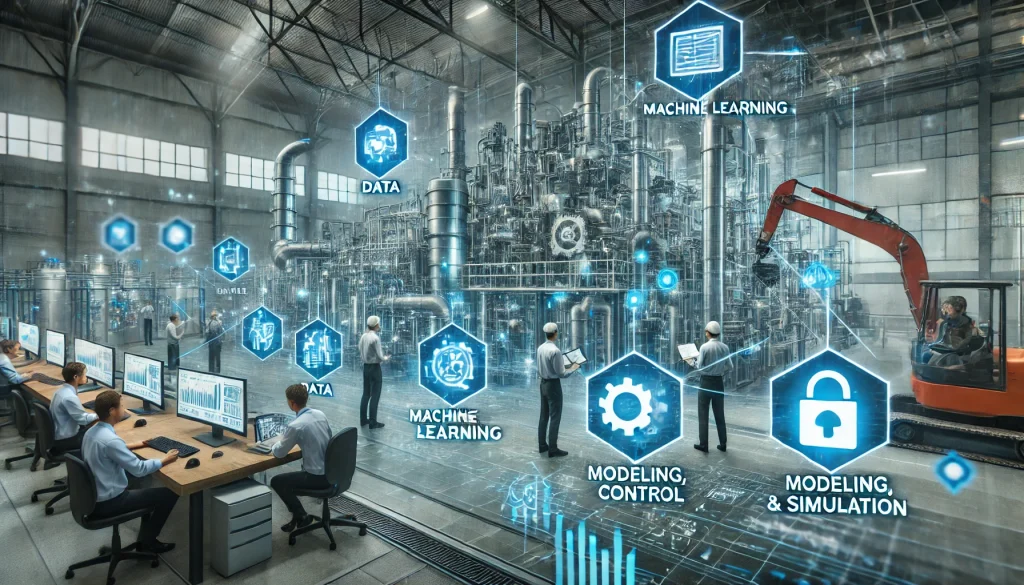Process Systems Engineering (PSE) is a multidisciplinary field that focuses on the design, modeling, analysis, control, and optimization of chemical and biochemical processes. At its core, PSE aims to improve the efficiency, safety, and environmental sustainability of industrial processes. Over the past decades, PSE has become a fundamental pillar in industries such as petrochemicals, pharmaceuticals, energy systems, and food processing, where the need for advanced process control and optimization has grown substantially.
PSE is driven by the use of mathematical modeling and computational tools to understand and improve process behavior, reduce costs, and enhance product quality. This field encompasses various stages of a process’s life cycle, from its initial design to its operational and control strategies, addressing both steady-state and dynamic aspects.
The Role of Mathematical Modeling in PSE
Mathematical modeling is at the heart of PSE, allowing engineers to simulate real-world processes in a virtual environment before implementation. This includes creating complex models that describe chemical reactions, transport phenomena, and phase behavior in both steady-state and dynamic conditions.
From my experience in Process Design and Synthesis, mathematical modeling is crucial not only for analyzing a given process but also for developing more detailed models that incorporate dynamic behavior and transport models for separation processes. One major challenge is the accurate simulation of nonideal systems involving multiple phases or highly nonlinear behaviors, often requiring advanced techniques such as differential-algebraic models (DAEs) or partial differential equations (PDEs).
Process Simulation: Challenges and Solutions
Process simulation is an essential tool in PSE, used extensively in the industry to assess the viability and efficiency of process designs. However, there are several challenges associated with process simulation, especially when dealing with complex chemical processes. These challenges include accurately modeling the dynamics of the process, dealing with multiphase systems, and incorporating the effects of various physical and chemical phenomena.
One area that stands out in my experience is the simulation of energy systems, where the integration of heat exchanger networks, heat pumps, and utility systems can lead to significant reductions in energy consumption. In the case of reactive distillation—a separation technique used to improve efficiency by combining reaction and separation in one unit—process simulation plays a key role in optimizing the performance of the entire system. This technique can lead to cost savings and is increasingly used in industries where energy efficiency is paramount.
Energy Systems Optimization in Process Design
Energy optimization is a critical focus in PSE, particularly as industries aim to reduce their environmental footprint and lower operational costs. The synthesis of heat exchanger networks and the integration of energy systems with utility operations is a powerful method to achieve energy savings.
In my work on energy systems, I’ve observed that optimization of energy use not only reduces consumption but also improves overall process efficiency. Modern energy systems must be designed to seamlessly integrate with renewable energy sources and adapt to changing demands while maintaining operational stability. The impact of these optimizations can lead to significant cost reductions and improved sustainability.
Advanced Separation Techniques and Their Industrial Impact
Separation processes, particularly for nonideal mixtures, represent one of the most challenging and critical tasks in chemical engineering. The design and synthesis of novel separation sequences can drastically improve the efficiency of processes by reducing waste, recovering valuable byproducts, and minimizing energy consumption.
In industries like petrochemicals, reactive distillation has proven to be a highly effective technique. By integrating reaction and separation within the same unit, the process becomes more compact and efficient. From my own experience in process simulation, these systems present both opportunities for innovation and challenges in modeling, especially when dealing with multiple phases and nonlinear behaviors.
Reactor Design and Process Efficiency
Reactors are fundamental to chemical processes, where raw materials are converted into desired products. The design of reactor networks, which includes nonlinear dynamics and complex chemical reactions, is a key area in PSE.
In my research and practice, I’ve found that the optimization of reactor design is critical for minimizing waste and maximizing the conversion of raw materials. The integration of chemical kinetics with process simulation allows for the development of reactors that not only operate efficiently but also contribute to the overall sustainability of the process. This is particularly important in processes where feedstock variability or operational uncertainties can impact performance.
Handling Uncertainty in Process Design
In PSE, designing processes that are robust under uncertainty is a significant challenge. Over the lifecycle of a process, factors such as fluctuating raw material costs, changing product demands, and varying environmental conditions can introduce uncertainty into the system.
During my work on design under uncertainty, I’ve focused on creating processes that are resilient to these fluctuations. This involves the development of multiperiod models that account for various operational scenarios, ensuring that the process remains profitable and efficient despite the inherent uncertainties. One of the key strategies I’ve implemented is designing processes that optimize performance over a range of conditions rather than under a single, static scenario.
Improving Process Operations through Optimization
Optimization is not limited to process design; it also plays a critical role in improving existing operations. Online optimization allows for real-time adjustments to process conditions based on changing inputs, such as raw material availability or market demands.
My experience with on-line optimization has shown that coupling advanced models with real-time data can lead to substantial increases in operational efficiency. By dynamically adjusting setpoints and control strategies, processes can adapt to fluctuations, ensuring higher profitability and reduced downtime.
Flexibility and Operability in Process Systems
Process flexibility is the ability of a system to handle changes in operational conditions without sacrificing performance. In practice, this means developing strategies that allow a process to operate efficiently across a range of scenarios, including changes in production rates, raw material quality, or product specifications.
Through my work on flexibility and operability, I’ve encountered the need to quantify these metrics and integrate them into the design phase. This leads to processes that are not only robust but also more adaptable to future changes, an essential feature in industries with highly variable operating conditions.
Real-Time Process Optimization and Control
Process control is a cornerstone of PSE, particularly with the rise of advanced model predictive control (MPC) and nonlinear control strategies. These control methods enable the continuous optimization of processes in real time, allowing systems to adapt to operational changes while maintaining stability and performance.
In my experience, integrating nonlinear control strategies has proven effective in processes where traditional linear models fail. Nonlinear models offer more accurate predictions and adjustments, especially in highly dynamic environments such as batch processes.
Process Scheduling for Maximum Efficiency
Process scheduling, especially in industries with both batch and continuous processes, plays a significant role in ensuring timely production and equipment utilization. Scheduling not only impacts profitability but also affects operational logistics, such as inventory management and maintenance planning.
One of the most challenging aspects I’ve dealt with in process scheduling is finding the balance between production demands and the availability of resources. Advanced optimization techniques can solve these complex scheduling problems, leading to improved delivery times and increased process efficiency.
Integration of Design, Control, and Operations
The ultimate goal of PSE is to integrate design, control, and operations into a cohesive framework that maximizes efficiency, profitability, and sustainability. By combining steady-state and dynamic models with advanced control systems, this approach ensures that processes operate at their optimal level.
In my work, I’ve seen that this integration leads to significant improvements in overall process performance. The challenge lies in developing models that can handle both continuous and discrete decision variables, ensuring that the system remains flexible and responsive to operational changes.
Supporting Tools and Methods for Process Systems Engineering
PSE relies on a wide range of tools and methodologies, from simulation software to optimization algorithms. These tools enable engineers to design, simulate, and optimize complex systems, often using advanced computational techniques such as parallel processing and global optimization.
In my experience, using these tools to model algebraic/differential systems and solve large-scale optimization problems has been critical in achieving the high-level goals of PSE. These tools are continuously evolving, providing more powerful solutions to the increasingly complex challenges faced by modern process industries.
Advanced Process Control (APC)
Advanced Process Control (APC) refers to a collection of techniques and technologies used to optimize…
Numerical and Computational Methods
Numerical and computational methods are essential tools in Process Systems Engineering (PSE), enabling engineers to…
Artificial Intelligence in Process Systems Engineering (PSE)
Artificial Intelligence (AI) has emerged as a transformative force in Process Systems Engineering (PSE), enabling…
Real-Time Applications and Digital Twins
Real-time applications (RTAs) are systems that process data instantaneously, delivering results or actions within predefined…
Process Systems Engineering (PSE)
Process Systems Engineering (PSE) is a multidisciplinary field that focuses on the design, modeling, analysis,…





